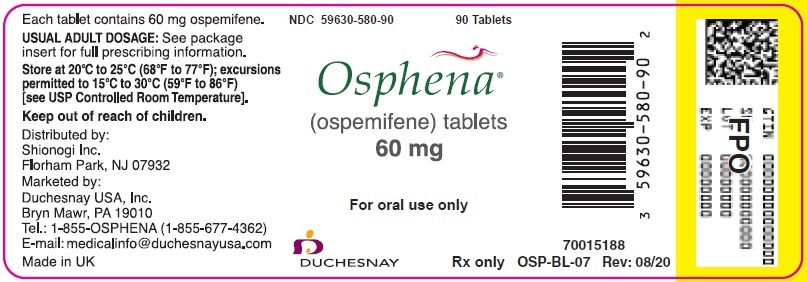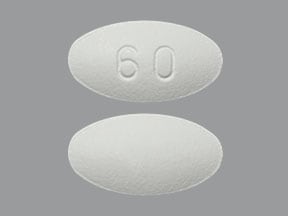Osphena
Generic name: ospemifene
Drug class: Selective estrogen receptor modulators
Medically reviewed by A Ras MD.
What is Osphena?
Osphena is a prescription medicine that contains ospemifene. Osphena is used after menopause for women with or without a uterus to treat moderate to severe pain during sexual intercourse due to changes in and around your vagina, and also moderate to severe vaginal dryness due to changes in and around your vagina.
Description
OSPHENA is an estrogen agonist/antagonist. OSPHENA is not a hormone. The chemical structure of ospemifene is shown in Figure 1.
 |
| Figure 1: Chemical Structure |
The chemical designation is Z-2-[4-(4-chloro-1,2-diphenylbut-1-enyl)phenoxy]ethanol, and has the empirical formula C24H23ClO2, which corresponds to a molecular weight of 378.9. Ospemifene is a white to off-white crystalline powder that is insoluble in water and soluble in ethanol.
Each OSPHENA tablet contains 60 mg of ospemifene. Inactive ingredients include colloidal silicon dioxide, hypromellose, lactose monohydrate, magnesium stearate, mannitol, microcrystalline cellulose, polyethylene glycol, povidone, pregelatinized starch, sodium starch glycolate, titanium dioxide, and triacetin.
Mechanism of Action
OSPHENA is an estrogen receptor agonist/antagonist with tissue selective effects. Its biological actions are mediated through binding to estrogen receptors. This binding results in activation of estrogenic pathways in some tissues (agonism) and blockade of estrogenic pathways in others (antagonism).
What is the most important information I should know about Osphena?
- Osphena is a medicine that works like estrogen in the lining of the uterus (womb) but can work differently in other parts of the body.
- Osphena may increase your chance of getting cancer of the lining of the uterus (womb). Vaginal bleeding after menopause may be a warning sign of cancer of the lining of the uterus (womb). Your healthcare provider should check any unusual vaginal bleeding to find out the cause. Tell your healthcare provider right away if you have any unusual vaginal bleeding while you are taking Osphena.
- Osphena may increase your chance of getting strokes and blood clots.
Who should not take Osphena?
Do not start taking Osphena if you:
- have unusual vaginal bleeding. Vaginal bleeding after menopause may be a warning sign of cancer of the lining of the uterus (womb). Your healthcare provider should check any unusual vaginal bleeding to find out the cause.
- currently have or have had certain cancers. If you have or have had cancer, talk with your healthcare provider about whether you should take Osphena.
- currently have or have had blood clots.
- had a stroke or heart attack.
- are allergic to ospemifene or any of the ingredients in Osphena. Allergic reaction to Osphena can include swelling of the face or tongue (angioedema), hives (urticaria), rash, and itching (pruritus). See the end of this Patient Information leaflet for a complete list of ingredients in Osphena.
- are pregnant or plan to become pregnant. Osphena is not for pregnant women.
What should I tell my healthcare provider before taking Osphena?
Before you take Osphena, tell your healthcare provider about all of your medical conditions, including if you:
- have any unusual vaginal bleeding.
- have or have had certain cancers. See “Who should not take Osphena?”
- have liver problems. You should not use Osphena if you have certain liver problems.
- are going to have surgery or will be on bed rest. Your healthcare provider will let you know if you need to stop taking Osphena.
- are breastfeeding or plan to breastfeed. It is not known if Osphena can pass into your breast milk. Do not breastfeed while taking Osphena.
Tell your healthcare provider about all medicines you take, including prescription and over-the-counter medicines, vitamins, and herbal supplements. Some medicines may affect how Osphena works. Osphena may also affect how other medicines work.
Know the medicines you take. Keep a list of your medicines and show it to your healthcare provider and pharmacist each time you get a new medicine.
How should I take Osphena?
- Take Osphena exactly how your healthcare provider tells you to take it.
- Take 1 Osphena tablet by mouth each day with food.
- You and your healthcare provider should talk regularly about the dose of Osphena you are taking and whether or not you still need treatment with Osphena.
What are the possible side effects of Osphena?
Osphena may cause serious side effects, including:
- See “What is the most important information I should know about Osphena?”
Serious, but less common side effects include:
- stroke
- blood clots
- cancer of the lining of the uterus (womb)
Call your healthcare provider right away if you get any of the following warning signs or any other unusual symptoms that concern you:
- unusual vaginal bleeding
- changes in vision or speech
- sudden new severe headaches
- pain in your chest or legs with or without shortness of breath, weakness and fatigue
Less serious, but common side effects include:
- hot flushes (also known as hot flashes)
- vaginal discharge
- muscle spasms
- headache
- nausea
- excessive sweating (hyperhidrosis)
- heavy vaginal bleeding (vaginal hemorrhage)
- night sweats
These are not all the possible side effects of Osphena. For more information, ask your healthcare provider or pharmacist. Tell your healthcare provider about any side effects that bother you or do not go away.
Call your doctor for medical advice about side effects. You may report side effects to FDA at 1-800-FDA-1088.
What can I do to lower my chances of a serious side effect with Osphena?
- Talk with your healthcare provider regularly about whether you should continue taking Osphena.
- See your healthcare provider right away if you get vaginal bleeding while taking Osphena.
- Have a pelvic exam, breast exam, and mammogram (breast X-ray) every year unless your healthcare provider tells you something else.
- If members of your family have had breast cancer or if you have ever had breast lumps or an abnormal mammogram (breast X-ray), you may need to have breast exams more often.
- If you have high blood pressure, high cholesterol, diabetes, are overweight, or use tobacco, you may have a higher chance of getting heart disease. Ask your healthcare provider for ways to lower your chances of getting heart disease.
- Tell your healthcare provider if you are going to have surgery or will be on bed rest.
General information about the safe and effective use of Osphena
Medicines are sometimes prescribed for purposes other than those listed in a Patient Information leaflet. Do not take Osphena for a condition for which it was not prescribed. Do not give Osphena to other people, even if they have the same symptoms you have. It may harm them.
This Patient Information leaflet summarizes the most important information about Osphena. If you would like more information, talk with your healthcare provider or pharmacist. You can ask your healthcare provider or pharmacist for information about Osphena that is written for health professionals.
How should I store Osphena?
- Store Osphena at room temperature between 68°F to 77°F (20°C to 25°C).
Keep Osphena and all medicines out of the reach of children.
What are the ingredients in Osphena?
Active Ingredient: ospemifene.
Inactive Ingredients: colloidal silicon dioxide, hypromellose, lactose monohydrate, magnesium stearate, mannitol, microcrystalline cellulose, polyethylene glycol, povidone, pregelatinized starch, sodium starch glycolate, titanium dioxide, and triacetin.
Label
PRINCIPAL DISPLAY PANEL – 60 MG TABLET BOTTLE LABEL
- NDC 59630-580-90
90 Tablets - Osphena®
(ospemifene) tablets
60 mg - For oral use only
- DUCHESNAY
Rx only


SRC: NLM .
